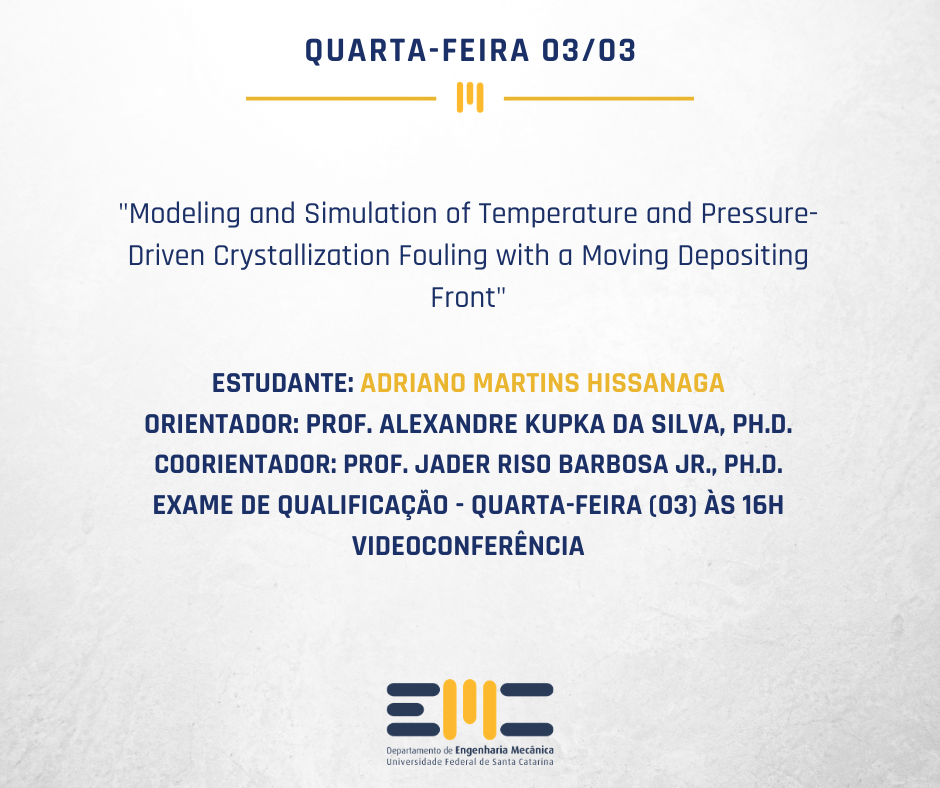

O estudante Adriano Martins Hissanaga, orientado pelo Prof. Alexandre Kupka da Silva, Ph.D. e coorientado por Prof. Jader Riso Barbosa Jr., Ph.D., fará seu exame de qualificação na próxima quarta-feira (03/03), às 16h, por videconferência. A defesa é vinculada ao Programa de Pós-Graduação em Engenharia Mecânica.
Banca:
Prof. Amir A. Martins de Oliveira Jr., Ph.D. (Presidente)
Prof.ª Cintia Soares, Dr.ª (POSENQ/UFSC)
Dr. André Leibsohn Martins (PETROBRÁS)
Dr. Marcus Vinicius Duarte Ferreira (PETROBRÁS)
Título: “Modeling and Simulation of Temperature and Pressure-Driven Crystallization Fouling with a Moving Depositing Front”
Resumo: Fouling is the undesired accumulation of materials on a solid surface to the detriment of its function. It is particularly a major problem affecting heat exchangers; several authors state that fouling is the least understood problem in heat exchanger theory and it still determines the design and operation of heat exchangers to a major extent. The fouling layer adds a substantial resistance to heat transfer, the fouling thermal resistance. The typical procedure adopted in the design of heat exchangers up to early 1950s was to assume a prescribed value of the fouling thermal resistance based on tabulated data available in literature. However, no information about the effect of the operational parameters (e.g. flow velocity, fluid temperature, heat flux, fluid composition) is included in this approach, but it is well known that these parameters strongly influence the fouling rate and, consequently, the thermal fouling resistance. An alternative and innovative approach that may be adopted in the design of heat exchangers is based on the calculation of deposition and removal fluxes of fouling on surfaces based on local conditions such as concentration, temperature, and shear rates which in turn strongly affect the fouling rates. It may be possible with numerical studies through computational fluid dynamics (CFD) codes. It is important to note that fouling simulation usually focuses on temperature-driven deposition that occurs on heat exchangers surfaces, based on the historical context of the development of this science. However, fouling is a major problem in the oil industries as well, especially regarding flow assurance. The deposition of CaCO3 involves the carbonate-equilibrium, which is particularly sensitive to pressure changes. The pressure-induced deposition process was not studied in the literature, at least not in the context of CFD simulations. Based on these observations, this thesis aims to study the multidimensional fouling phenomenon in a CFD code including the evaluation of local effects, as well as the simulation of the pressuredriven deposition process. The mathematical framework was validated with experimental data obtained from the literature. Preliminary results of the initial fouling model, when the fouling layer is so thin that it does not affect the flow scales, shows a good agreement between experimental and simulated data, with good accordance of the transfer coefficients when compared to correlation results. In the next step of this research, the moving boundary will be implemented in the CFD code to account for the effects of the fouling layer growth on the transport phenomena. Additionally, the pressure-driven deposition process will also be implemented in order to evaluate the potentials of this model.
Palavras-chave: Crystallization fouling, modeling, simulation, CFD, moving boundary, pressure-driven fouling



